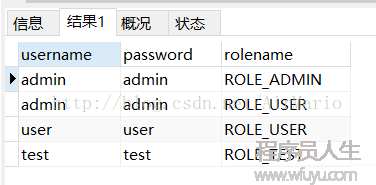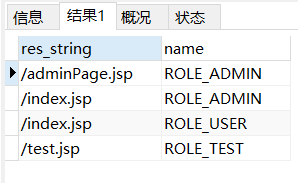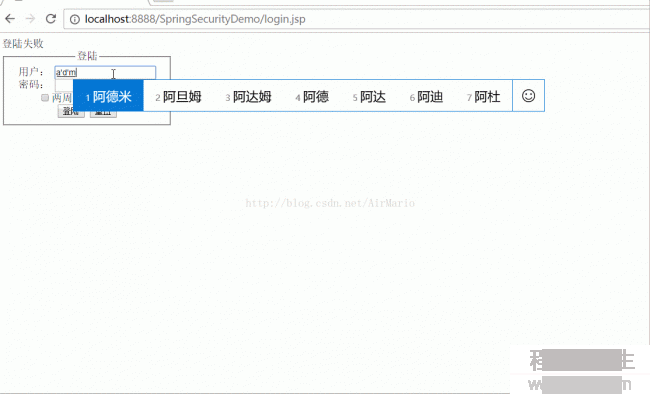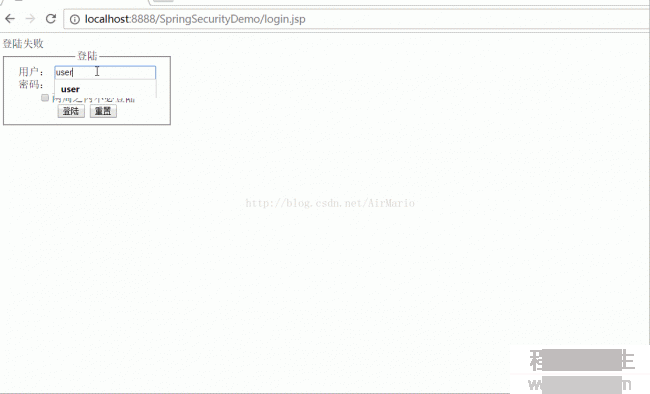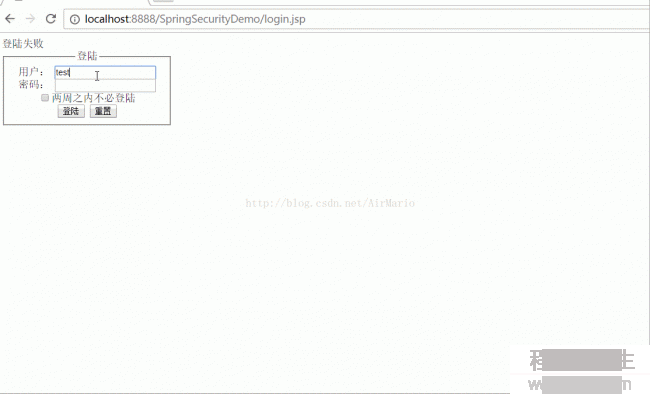在之前的幾篇security教程中,資源和所對應(yīng)的權(quán)限都是在xml中進(jìn)行配置的,也就在http標(biāo)簽中配置intercept-url,試想要是配置的對象不多,那還好,但是平常實(shí)際開發(fā)中都常常是非常多的資源和權(quán)限對應(yīng),而且寫在配置文件里面寫改起來還得該源碼配置文件,這明顯是不好的。因此接下來,將用數(shù)據(jù)庫管理資源和權(quán)限的對應(yīng)關(guān)系。數(shù)據(jù)庫還是接著之前的,用mysql數(shù)據(jù)庫,因此也不用另外引入額外的jar包。
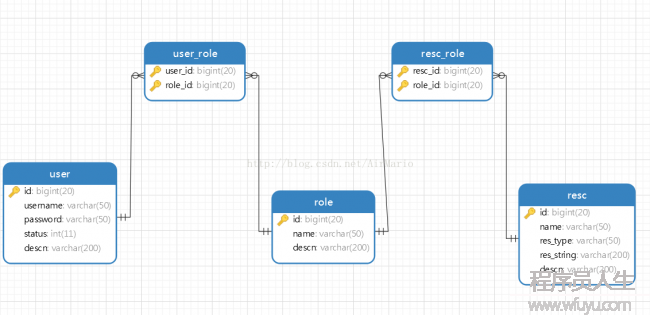
DROP TABLE IF EXISTS `resc`;
CREATE TABLE `resc` (
`id` bigint(20) NOT NULL DEFAULT '0',
`name` varchar(50) DEFAULT NULL,
`res_type` varchar(50) DEFAULT NULL,
`res_string` varchar(200) DEFAULT NULL,
`descn` varchar(200) DEFAULT NULL,
PRIMARY KEY (`id`)
) ENGINE=InnoDB DEFAULT CHARSET=utf8;
-- ----------------------------
-- Records of resc
-- ----------------------------
INSERT INTO `resc` VALUES ('1', '', 'URL', '/adminPage.jsp', '管理員頁面');
INSERT INTO `resc` VALUES ('2', '', 'URL', '/index.jsp', '');
INSERT INTO `resc` VALUES ('3', null, 'URL', '/test.jsp', '測試頁面');
-- ----------------------------
-- Table structure for resc_role
-- ----------------------------
DROP TABLE IF EXISTS `resc_role`;
CREATE TABLE `resc_role` (
`resc_id` bigint(20) NOT NULL DEFAULT '0',
`role_id` bigint(20) NOT NULL DEFAULT '0',
PRIMARY KEY (`resc_id`,`role_id`),
KEY `fk_resc_role_role` (`role_id`),
CONSTRAINT `fk_resc_role_role` FOREIGN KEY (`role_id`) REFERENCES `role` (`id`),
CONSTRAINT `fk_resc_role_resc` FOREIGN KEY (`resc_id`) REFERENCES `resc` (`id`)
) ENGINE=InnoDB DEFAULT CHARSET=utf8;
-- ----------------------------
-- Records of resc_role
-- ----------------------------
INSERT INTO `resc_role` VALUES ('1', '1');
INSERT INTO `resc_role` VALUES ('2', '1');
INSERT INTO `resc_role` VALUES ('2', '2');
INSERT INTO `resc_role` VALUES ('3', '3');
-- ----------------------------
-- Table structure for role
-- ----------------------------
DROP TABLE IF EXISTS `role`;
CREATE TABLE `role` (
`id` bigint(20) NOT NULL DEFAULT '0',
`name` varchar(50) DEFAULT NULL,
`descn` varchar(200) DEFAULT NULL,
PRIMARY KEY (`id`)
) ENGINE=InnoDB DEFAULT CHARSET=utf8;
-- ----------------------------
-- Records of role
-- ----------------------------
INSERT INTO `role` VALUES ('1', 'ROLE_ADMIN', '管理員角色');
INSERT INTO `role` VALUES ('2', 'ROLE_USER', '用戶角色');
INSERT INTO `role` VALUES ('3', 'ROLE_TEST', '測試角色');
-- ----------------------------
-- Table structure for t_c3p0
-- ----------------------------
DROP TABLE IF EXISTS `t_c3p0`;
CREATE TABLE `t_c3p0` (
`a` char(1) DEFAULT NULL
) ENGINE=InnoDB DEFAULT CHARSET=utf8;
-- ----------------------------
-- Records of t_c3p0
-- ----------------------------
-- ----------------------------
-- Table structure for user
-- ----------------------------
DROP TABLE IF EXISTS `user`;
CREATE TABLE `user` (
`id` bigint(20) NOT NULL DEFAULT '0',
`username` varchar(50) DEFAULT NULL,
`password` varchar(50) DEFAULT NULL,
`status` int(11) DEFAULT NULL,
`descn` varchar(200) DEFAULT NULL,
PRIMARY KEY (`id`)
) ENGINE=InnoDB DEFAULT CHARSET=utf8;
-- ----------------------------
-- Records of user
-- ----------------------------
INSERT INTO `user` VALUES ('1', 'admin', 'admin', '1', '管理員');
INSERT INTO `user` VALUES ('2', 'user', 'user', '1', '用戶');
INSERT INTO `user` VALUES ('3', 'test', 'test', '1', '測試');
-- ----------------------------
-- Table structure for user_role
-- ----------------------------
DROP TABLE IF EXISTS `user_role`;
CREATE TABLE `user_role` (
`user_id` bigint(20) NOT NULL DEFAULT '0',
`role_id` bigint(20) NOT NULL DEFAULT '0',
PRIMARY KEY (`user_id`,`role_id`),
KEY `fk_user_role_role` (`role_id`),
CONSTRAINT `fk_user_role_role` FOREIGN KEY (`role_id`) REFERENCES `role` (`id`),
CONSTRAINT `fk_user_role_user` FOREIGN KEY (`user_id`) REFERENCES `user` (`id`)
) ENGINE=InnoDB DEFAULT CHARSET=utf8;
-- ----------------------------
-- Records of user_role
-- ----------------------------
INSERT INTO `user_role` VALUES ('1', '1');
INSERT INTO `user_role` VALUES ('1', '2');
INSERT INTO `user_role` VALUES ('2', '2');
INSERT INTO `user_role` VALUES ('3', '3');user表中包括用戶登陸信息,role角色表中包括授權(quán)信息,resc資源表中包括需要保護(hù)的資源。Spring Security需要的數(shù)據(jù)不過就是pattern和access類似鍵值對的數(shù)據(jù),就像配置文件中寫的那樣:
<intercept-url pattern="/login.jsp" access="IS_AUTHENTICATED_ANONYMOUSLY" />1 <intercept-url pattern="/admin.jsp" access="ROLE_ADMIN" /> <intercept-url pattern="/**" access="ROLE_USER" />
其實(shí)當(dāng)項(xiàng)目啟動時,Spring Security所做的就是在系統(tǒng)初始化時,將以上XML中的信息轉(zhuǎn)換為特定的數(shù)據(jù)格式,而框架中其他組件可以利用這些特定格式的數(shù)據(jù),用于控制以后的驗(yàn)證操作。現(xiàn)在我們將這些信息存儲在數(shù)據(jù)庫中,因此就要想辦法從數(shù)據(jù)庫中查詢這些數(shù)據(jù),所以根據(jù)security數(shù)據(jù)的需要,只需要以下sql語句就能夠:
select re.res_string,r.name from role r,resc re,resc_role rr where r.id=rr.role_id and re.id=rr.resc_id在數(shù)據(jù)中履行這條語句做測試,得到以下結(jié)果:

這樣的格式正是security所需要的數(shù)據(jù)。
package com.zmc.demo; import java.sql.ResultSet; import java.sql.SQLException; import java.util.ArrayList; import java.util.Collection; import java.util.LinkedHashMap; import java.util.List; import javax.sql.DataSource; import org.springframework.jdbc.core.support.JdbcDaoSupport; import org.springframework.jdbc.object.MappingSqlQuery; import org.springframework.security.access.ConfigAttribute; import org.springframework.security.access.SecurityConfig; import org.springframework.security.web.access.intercept.DefaultFilterInvocationSecurityMetadataSource; import org.springframework.security.web.util.AntPathRequestMatcher; import org.springframework.security.web.util.RequestMatcher; /** * @classname JdbcRequestMapBulider * @author ZMC * @time 2017⑴⑴0 * 查詢資源和角色,并構(gòu)建RequestMap */ public class JdbcRequestMapBulider extends JdbcDaoSupport{ //查詢資源和權(quán)限關(guān)系的sql語句 private String resourceQuery = ""; public String getResourceQuery() { return resourceQuery; } //查詢資源 public List<Resource> findResources() { ResourceMapping resourceMapping = new ResourceMapping(getDataSource(), resourceQuery); return resourceMapping.execute(); } //拼接RequestMap public LinkedHashMap<RequestMatcher, Collection<ConfigAttribute>> buildRequestMap() { LinkedHashMap<RequestMatcher, Collection<ConfigAttribute>> requestMap = new LinkedHashMap<>(); List<Resource> resourceList = this.findResources(); for (Resource resource : resourceList) { RequestMatcher requestMatcher = this.getRequestMatcher(resource.getUrl()); List<ConfigAttribute> list = new ArrayList<ConfigAttribute>(); list.add(new SecurityConfig(resource.getRole())); requestMap.put(requestMatcher, list); } return requestMap; } //通過1個字符串地址構(gòu)建1個AntPathRequestMatcher對象 protected RequestMatcher getRequestMatcher(String url) { return new AntPathRequestMatcher(url); } public void setResourceQuery(String resourceQuery) { this.resourceQuery = resourceQuery; } /** * @classname Resource * @author ZMC * @time 2017⑴⑴0 * 資源內(nèi)部類 */ private class Resource { private String url;//資源訪問的地址 private String role;//所需要的權(quán)限 public Resource(String url, String role) { this.url = url; this.role = role; } public String getUrl() { return url; } public String getRole() { return role; } } private class ResourceMapping extends MappingSqlQuery { protected ResourceMapping(DataSource dataSource, String resourceQuery) { super(dataSource, resourceQuery); compile(); } //對結(jié)果集進(jìn)行封裝處理 protected Object mapRow(ResultSet rs, int rownum) throws SQLException { String url = rs.getString(1); String role = rs.getString(2); Resource resource = new Resource(url, role); return resource; } } }說明:
resourceQuery是查詢數(shù)據(jù)的sql語句,該屬性在配置bean的時候傳入便可。
內(nèi)部創(chuàng)建了1個resource來封裝數(shù)據(jù)。
getRequestMatcher方法就是用來創(chuàng)建RequestMatcher對象的
buildRequestMap方法用來最后拼接成LinkedHashMap<RequestMatcher, Collection<ConfigAttribute>>共security使用。
在將這部之前,先得了解大概下security的運(yùn)行進(jìn)程,security實(shí)現(xiàn)控制的功能其實(shí)就是通過1系列的攔截器來實(shí)現(xiàn)的,當(dāng)用戶登陸的時候,會被AuthenticationProcessingFilter攔截,調(diào)用AuthenticationManager的實(shí)現(xiàn)類,同時AuthenticationManager會調(diào)用ProviderManager來獲得用戶驗(yàn)證信息,其中不同的Provider調(diào)用的服務(wù)不同,由于這些信息可以是在數(shù)據(jù)庫上,可以是在LDAP服務(wù)器上,可以是xml配置文件上等,這個例子中就是為數(shù)據(jù)庫;如果驗(yàn)證通過后會將用戶的權(quán)限信息放到spring的全局緩存SecurityContextHolder中,以備后面訪問資源時使用。當(dāng)訪問資源,訪問url時,會通過AbstractSecurityInterceptor攔截器攔截,其中會調(diào)用FilterInvocationSecurityMetadataSource的方法來獲得被攔截url所需的全部權(quán)限,其中FilterInvocationSecurityMetadataSource的經(jīng)常使用的實(shí)現(xiàn)類為DefaultFilterInvocationSecurityMetadataSource,這個類中有個很關(guān)鍵的東西就是requestMap,也就是我們上面所得到的數(shù)據(jù),在調(diào)用授權(quán)管理器AccessDecisionManager,這個授權(quán)管理器會通過spring的全局緩存SecurityContextHolder獲得用戶的權(quán)限信息,還會獲得被攔截的url和被攔截url所需的全部權(quán)限,然后根據(jù)所配的策略,如果權(quán)限足夠,則返回,權(quán)限不夠則報錯并調(diào)用權(quán)限不足頁面。
根據(jù)源碼debug跟蹤得出,其實(shí)資源權(quán)限關(guān)系就放在DefaultFilterInvocationSecurityMetadataSource的requestMap,中的,這個requestMap就是我們JdbcRequestMapBulider.buildRequestMap()方法所需要的數(shù)據(jù)類型,因此,順氣自然就想到了我們自定義1個類繼承FilterInvocationSecurityMetadataSource接口,將數(shù)據(jù)查出的數(shù)據(jù)放到requestMap中去。制定類MyFilterInvocationSecurityMetadataSource繼承FilterInvocationSecurityMetadataSource和InitializingBean接口。
package com.zmc.demo; import java.util.Collection; import java.util.HashSet; import java.util.List; import java.util.Map; import java.util.Set; import javax.servlet.http.HttpServletRequest; import org.springframework.beans.factory.InitializingBean; import org.springframework.security.access.ConfigAttribute; import org.springframework.security.web.FilterInvocation; import org.springframework.security.web.access.intercept.FilterInvocationSecurityMetadataSource; import org.springframework.security.web.util.RequestMatcher; /** * @classname MyFilterInvocationSecurityMetadataSource * @author ZMC * @time 2017⑴⑴0 */ public class MyFilterInvocationSecurityMetadataSource implements FilterInvocationSecurityMetadataSource, InitializingBean { private final static List<ConfigAttribute> NULL_CONFIG_ATTRIBUTE = null; // 資源權(quán)限集合 private Map<RequestMatcher, Collection<ConfigAttribute>> requestMap; //查找數(shù)據(jù)庫權(quán)限和資源關(guān)系 private JdbcRequestMapBulider builder; /* * (non-Javadoc) * @see * org.springframework.security.access.SecurityMetadataSource#getAttributes * (java.lang.Object) * 更具訪問資源的地址查找所需要的權(quán)限 */ @Override public Collection<ConfigAttribute> getAttributes(Object object) throws IllegalArgumentException { final HttpServletRequest request = ((FilterInvocation) object) .getRequest(); Collection<ConfigAttribute> attrs = NULL_CONFIG_ATTRIBUTE; for (Map.Entry<RequestMatcher, Collection<ConfigAttribute>> entry : requestMap .entrySet()) { if (entry.getKey().matches(request)) { attrs = entry.getValue(); break; } } return attrs; } /* * (non-Javadoc) * * @see org.springframework.security.access.SecurityMetadataSource# * getAllConfigAttributes() * 獲得所有的權(quán)限 */ @Override public Collection<ConfigAttribute> getAllConfigAttributes() { Set<ConfigAttribute> allAttributes = new HashSet<ConfigAttribute>(); for (Map.Entry<RequestMatcher, Collection<ConfigAttribute>> entry : requestMap .entrySet()) { allAttributes.addAll(entry.getValue()); } System.out.println("總共有這些權(quán)限:"+allAttributes.toString()); return allAttributes; } /* * (non-Javadoc) * * @see * org.springframework.security.access.SecurityMetadataSource#supports(java * .lang.Class) */ @Override public boolean supports(Class<?> clazz) { return FilterInvocation.class.isAssignableFrom(clazz); } //綁定requestMap protected Map<RequestMatcher, Collection<ConfigAttribute>> bindRequestMap() { return builder.buildRequestMap(); } /* * (non-Javadoc) * * @see * org.springframework.beans.factory.InitializingBean#afterPropertiesSet() */ @Override public void afterPropertiesSet() throws Exception { this.requestMap = this.bindRequestMap(); } public void refreshResuorceMap() { this.requestMap = this.bindRequestMap(); } //get方法 public JdbcRequestMapBulider getBuilder() { return builder; } //set方法 public void setBuilder(JdbcRequestMapBulider builder) { this.builder = builder; } }說明:
requestMap這個屬性就是用來寄存資源權(quán)限的集合
builder為JdbcRequestMapBulider類型,用來查找數(shù)據(jù)庫權(quán)限和資源關(guān)系
其他的代碼中都有詳細(xì)的注釋
<?xml version="1.0" encoding="UTF⑻"?>
<beans:beans xmlns="http://www.springframework.org/schema/security"
xmlns:beans="http://www.springframework.org/schema/beans" xmlns:xsi="http://www.w3.org/2001/XMLSchema-instance"
xsi:schemaLocation="http://www.springframework.org/schema/beans
http://www.springframework.org/schema/beans/spring-beans⑶.0.xsd
http://www.springframework.org/schema/context
http://www.springframework.org/schema/context/spring-context⑶.1.xsd
http://www.springframework.org/schema/tx
http://www.springframework.org/schema/tx/spring-tx⑶.0.xsd
http://www.springframework.org/schema/security
http://www.springframework.org/schema/security/spring-security.xsd">
<http pattern="/login.jsp" security="none"></http>
<http auto-config="false">
<form-login login-page="/login.jsp" default-target-url="/index.jsp"
authentication-failure-url="/login.jsp?error=true" />
<logout invalidate-session="true" logout-success-url="/login.jsp"
logout-url="/j_spring_security_logout" />
<!-- 通過配置custom-filter來增加過濾器,before="FILTER_SECURITY_INTERCEPTOR"表示在SpringSecurity默許的過濾器之前履行。 -->
<custom-filter ref="filterSecurityInterceptor" before="FILTER_SECURITY_INTERCEPTOR" />
</http>
<!-- 數(shù)據(jù)源 -->
<beans:bean id="dataSource" class="com.mchange.v2.c3p0.ComboPooledDataSource"
destroy-method="close">
<!-- 此為c3p0在spring中直接配置datasource c3p0是1個開源的JDBC連接池 -->
<beans:property name="driverClass" value="com.mysql.jdbc.Driver" />
<beans:property name="jdbcUrl"
value="jdbc:mysql://localhost:3306/springsecuritydemo?useUnicode=true&characterEncoding=UTF⑻" />
<beans:property name="user" value="root" />
<beans:property name="password" value="" />
<beans:property name="maxPoolSize" value="50"></beans:property>
<beans:property name="minPoolSize" value="10"></beans:property>
<beans:property name="initialPoolSize" value="10"></beans:property>
<beans:property name="maxIdleTime" value="25000"></beans:property>
<beans:property name="acquireIncrement" value="1"></beans:property>
<beans:property name="acquireRetryAttempts" value="30"></beans:property>
<beans:property name="acquireRetryDelay" value="1000"></beans:property>
<beans:property name="testConnectionOnCheckin" value="true"></beans:property>
<beans:property name="idleConnectionTestPeriod" value="18000"></beans:property>
<beans:property name="checkoutTimeout" value="5000"></beans:property>
<beans:property name="automaticTestTable" value="t_c3p0"></beans:property>
</beans:bean>
<beans:bean id="builder" class="com.zmc.demo.JdbcRequestMapBulider">
<beans:property name="dataSource" ref="dataSource" />
<beans:property name="resourceQuery"
value="select re.res_string,r.name from role r,resc re,resc_role rr where
r.id=rr.role_id and re.id=rr.resc_id" />
</beans:bean>
<!-- 認(rèn)證過濾器 -->
<beans:bean id="filterSecurityInterceptor"
class="org.springframework.security.web.access.intercept.FilterSecurityInterceptor">
<!-- 用戶具有的權(quán)限 -->
<beans:property name="accessDecisionManager" ref="accessDecisionManager" />
<!-- 用戶是不是具有所要求資源的權(quán)限 -->
<beans:property name="authenticationManager" ref="authenticationManager" />
<!-- 資源與權(quán)限對應(yīng)關(guān)系 -->
<beans:property name="securityMetadataSource" ref="securityMetadataSource" />
</beans:bean>
<!-- 授權(quán)管理器 -->
<beans:bean class="com.zmc.demo.MyAccessDecisionManager" id="accessDecisionManager">
</beans:bean>
<!--認(rèn)證管理-->
<authentication-manager alias="authenticationManager">
<authentication-provider>
<jdbc-user-service data-source-ref="dataSource" id="usersService"
users-by-username-query="select username,password,status as enabled from user where username = ?"
authorities-by-username-query="select user.username,role.name from user,role,user_role
where user.id=user_role.user_id and
user_role.role_id=role.id and user.username=?" />
</authentication-provider>
</authentication-manager>
<!--自定義的切入點(diǎn)-->
<beans:bean id="securityMetadataSource"
class="com.zmc.demo.MyFilterInvocationSecurityMetadataSource">
<beans:property name="builder" ref="builder"></beans:property>
</beans:bean>
</beans:beans>
package com.zmc.demo; import java.util.Collection; import java.util.Iterator; import org.springframework.security.access.AccessDecisionManager; import org.springframework.security.access.AccessDeniedException; import org.springframework.security.access.ConfigAttribute; import org.springframework.security.authentication.InsufficientAuthenticationException; import org.springframework.security.core.Authentication; import org.springframework.security.core.GrantedAuthority; /** * @classname MyAccessDecisionManager * @author ZMC * @time 2017⑴⑴0 * */ public class MyAccessDecisionManager implements AccessDecisionManager { /* (non-Javadoc) * @see org.springframework.security.access.AccessDecisionManager#decide(org.springframework.security.core.Authentication, java.lang.Object, java.util.Collection) * 該方法決定該權(quán)限是不是有權(quán)限訪問該資源,其實(shí)object就是1個資源的地址,authentication是當(dāng)前用戶的 * 對應(yīng)權(quán)限,如果沒登陸就為游客,登陸了就是該用戶對應(yīng)的權(quán)限 */ @Override public void decide(Authentication authentication, Object object, Collection<ConfigAttribute> configAttributes) throws AccessDeniedException, InsufficientAuthenticationException { if(configAttributes == null) { return; } //所要求的資源具有的權(quán)限(1個資源對多個權(quán)限) Iterator<ConfigAttribute> iterator = configAttributes.iterator(); while(iterator.hasNext()) { ConfigAttribute configAttribute = iterator.next(); //訪問所要求資源所需要的權(quán)限 String needPermission = configAttribute.getAttribute(); System.out.println("訪問"+object.toString()+"需要的權(quán)限是:" + needPermission); //用戶所具有的權(quán)限authentication Collection<? extends GrantedAuthority> authorities = authentication.getAuthorities(); for(GrantedAuthority ga : authorities) { if(needPermission.equals(ga.getAuthority())) { return; } } } //沒有權(quán)限 throw new AccessDeniedException(" 沒有權(quán)限訪問! "); } @Override public boolean supports(ConfigAttribute attribute) { // TODO Auto-generated method stub return true; } @Override public boolean supports(Class<?> clazz) { // TODO Auto-generated method stub return true; } }
